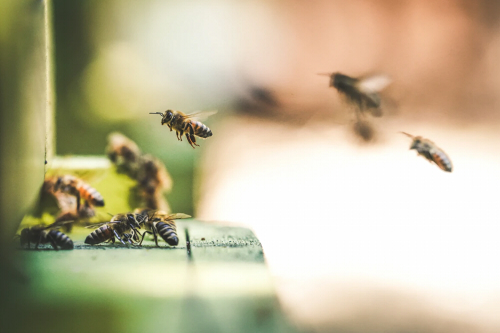Inspecting Hives for Mites: Volunteers Try to Help Bees Without Getting Stung
Carl Gold
Fall is here, and the foraging is not easy. Angry bees are swarming all over me – flying into the mesh covering my face, landing all over the rest of my head-to-ankle, borrowed, brilliant-white bee suit. They are not fooled.
I’m helping an expert beekeeper check hives for the number one hive destroyer – Varroa mites. Mites, and the viruses they carry, cause more honeybee colony loss in North America and Europe than climate change, bears or pesticides. They are ectoparasites, meaning they live on the outside of their host, and natives of Asia. Varroa mites are not harmful to humans or animals, except for laying waste to hives that we rely on for honey and pollination of food crops. Once a hive is infected, some of the survivors will abscond to other hives, spreading the mites. When other bees sense a hive is weakening (not understanding that it is because of mites), they will rob it and spread the mites even more. So far, nature has not evolved a solution.

Varroa mites look like deer ticks, only smaller. They enter the bee brood cells where the larvae develop. The mites puncture the larvae to feed. Some bees have developed resistance to mites, but most of our European bees (almost all honeybees in America are immigrants) cannot survive attack by the Varroa absent human aid.
Beekeepers must first determine if their hives are infected with enough mites to endanger the hive. Generally, an infestation of more than three mites per 100 bees calls for intervention. Unfortunately, the only way to tell if the hive is infested, other than a postmortem examination after they all die, is to pull the hive apart. By late summer, early fall there is not much nectar to be had so just like humans, the bees are hangry.
We gently pull the top off the hive but need a hive tool to pull out the combs. Think a thicker and shorter version of the unlocking “tool” used to slide between a car window and door. This takes some force, and the bees who were not upset when the top was pulled off are now in full attack mode. The smoke that normally keeps them docile is useless. It’s as if they know what is coming. They cover the mesh protecting my face and are all over the rest of my bee suit. My borrowed gloves have the scent of previous interventions, which also attracts the defenders.
To test for mites, we take a bee covered comb, make sure the queen is not present, and knock the bees into a plastic tub. This displaces lots of furious and now stunned bees. We scoop up a half cup of the approximately 300 outraged bees and quickly dump them into a small cylindrical container with an interior colander. It is full of alcohol. The alcohol kills the bees who are sacrificed in the name of consequentialism. Any mites on the bees are separated by the colander and fall through to the container.
It’s not easy to see the mites in the alcohol filled container through the protective mesh around my face, but careful counting is essential. Although tiny, they are visible to the naked eye. I initially think they are swimming but they are just as dead as the bees. I see five mites and know we have to treat. Treatment requires placing a small container of a jell like substance about the size of a chewing tobacco tin but thinner, on top of one of the brood combs. The bees walk on the jell and spread it throughout the hive, killing the mites.
We put the hive back together and step away. It takes a few minutes for the bees to leave us, and both my companions get stung when they remove their protective gear too quickly. Neither care – it’s a badge of valor. Happily unstung, I choose discretion.








